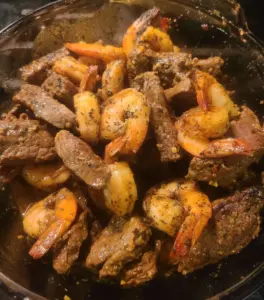Skip to Ingredients | Skip to Quick Recipe | Skip to Detailed Story and How-to
So, the inspiration behind this post is that yesterday was my night to cook dinner for the family, and I was fresh out of ideas. So, I decided to consult with ChatGPT to see if it could produce anything better than cake-is-a-lie recipes full of fish-shaped toxic resins. And, damn, was I pleasantly surprised!?
Before I get into it, to preface, I just want to say that I didn’t simply ask the chat bot to make all my decisions for me and hand me a recipe. I have been cooking Iron Chef style for over 30 years now – making meals from literally whatever happened to be on hand in the fridge at that given moment. This was a conversation with ChatGPT o3, during which I would occasionally shoot down its suggestions. At the end of the day, I didn’t follow all of its recipe instructions to the letter, but rather I did whatever felt right in the moment or would favor getting all the components to the table at the same time and efficiently.
I’m no meat puppet; we are a centaur. The result was a meal so good that I even impressed myself, which is a very hard thing to do. Left the kitchen feeling like starting my own restaurant might not be such a moon shot after all. And, I went to bed literally fantasizing about the flavor and aroma of this dish.
So, why is it called “Unstuck”? Well, odd story. About a week ago, my wife tried Ozempic for the first time. Her doctor started her on too high a dose, and the results were catastrophic. Being backed up isn’t much fun to talk about, but when it is so bad that you literally cannot enjoy a delicious meal, you know you’re in real trouble. With additional meds, she has been coping — but I wanted to make something for her that would settle her belly issues and help keep things moving along.
Thus, the combination of herbs and spices in this dish is engineered to promote motility. Will it send you running for the restroom like my four alarm pumpkin chili would? No, this is more like a gentle nudge. I wasn’t trying to push anybody off the back of a truck.
Shopping List
These ingredients feed 4 to 6 people with some to spare. Depends on how hungry people are though, I suppose. Don’t be shocked if folks want seconds.
Produce:
- 1 bundle of large bok choy, or package of baby bok
- 1 package of shiitake mushrooms, sliced
- 1/2 large white / Vidalia onion
- 1/2 medium sized fresh ginger root
Protein:
- 2 or 3 lbs. of thick cut London Broil steak
- 1lb. of frozen raw jumbo shrimps, peeled. I prefer them with the tails left on, but that is entirely up to your preferences
Pasta / Soup:
- 1 package of dried udon noodles
- 2-3 tbsp white miso paste
Spices, Etc.:
- Minced garlic (about a 1/2 cup in total)
- Neutral cooking oil
(peanut or avocado; olive or canola in a pinch) - Sesame oil
- Soy sauce
- Fresh lemongrass, or sub lemongrass paste
- Ground turmeric (3 tbsp – 1/4 cup)
- Thai basil, fresh or dried
- 1 whole star anise pod
- 2 whole cardamom pods
- 1 whole clove
- 1 small cinnamon stick, or sub a dash (1/2 to 1 tsp) of ground cinnamon
- 1 to 2 Tbsp sambal oelek (chili garlic sauce)
- Hot chili or sesame chili oil
- Crushed red pepper flakes
- Old Bay seasoning (because you knew I had to, right?)
Quick Recipe
Total cook time is about 90 minutes, including prep.
- In a saucepan with 6 cups of cold water, add miso paste, lemongrass, anise, crushed cardamom pods, clove, and cinnamon. Stir and heat to boil.
- Prepare ingredients while waiting for broth to come to temperature.
- Add udon noodles to broth, reduce heat to barely-bubbling (usually medium-low). Allow broth to simmer while cooking other ingredients, keeping an eye on it from time to time, so it doesn’t reduce to much.
- Dice half the ginger and combine in a wok with neutral oil, turmeric, 2 fistfuls of garlic. Heat on high. Add beef. Stir-sear for 1 to 3 minutes until medium rare. Set aside.
- Add sesame oil to wok, heat to high, and add shrimp. Season with sambal (1 to 2 tbsp), chili oil (1 tbsp), red pepper flake (1 tbsp), and Old Bay (1 to 3 tsp) to taste. Cover and stir occasionally for 4 to 6 minutes, until properly cooked through. Set aside on top of beef.
- Add more neutral oil to wok, along with onions, mushrooms and remainder of ginger strips. Heat on high until caramelization begins. Add mirin to base of wok (about 1/4 to 1/2 pint, just enough to not quite cover the onion/mushroom mix). Let liquid begin to steam. Add bok choy, white parts first, then greens. Cover and let cook for 4 to 5 minutes. Stir and set-aside for serving or combining with protein as desired.
- Check the broth. If reduced and udon have absorbed most of the miso, strain the solid herbs (anise, clove, cardamom, cinnamon) from the pot before serving.
- Add Thai basil to the protein and toss mixture to combine.
- Serve mixed protein and vegetables over noodles and broth in a bowl.
Cooking The Dish
Every good chef starts by doing as much prep work as you possibly can. After all, you never know what might go wrong in the middle of cooking. Stir fry / wok cooking can get especially energetic too – more on that later.
Here’s some pre-cooking prep advice that’ll get you off on the right foot.
- Choose a ‘neutral’ cooking oil with a high smoke temperature. (If you can’t use peanut, then avocado is good, olive oil is fine, or even plain ol’ vegetable oil.)
- Cross-cut the London Broil into strips about 3/4″ thick and then cut down into roughly bite sized oblongs.
- Remember to defrost your shrimp in cold water, then let them rest on a bed of paper towels, pat them dry.
- If your shrimp aren’t pre-peeled, take care of that ahead of time. I prefer shrimp with the tails left on, but that is entirely up to your preferences if you want to remove them.
- Cut onion into 1/4″ thin strips.
- Mushrooms should be sliced, just in case you bought them whole.
- For bok choy, remove the stump, cut the white part into slices about 1/2-1″ each, cut greens into pieces roughly the size of whole leaf spinach, wash and rinse to remove any dirt.
- Cut ginger into smallish french-fry-sized sticks.
- Fresh Thai basil should be finely minced.
- Fresh lemongrass should be sliced into thin strips and smashed. (Save yourself a lot of effort and just buy the tube of paste.)
- For minced garlic, there’s no need to make it fresh. Use the stuff that comes in a jar because you’ll need a lot of it.
Miso Udon Reduction – With a Twist
So, in this case, we want to begin by putting the miso broth on the stove and getting it started to boil.
In a large saucepan, I combined about two large tablespoons of miso paste in approx. 6 cups of water. If you have made miso soup from base before, the proportions should seem pretty intuitive. We want a nice thick base that is not too salty.
Add the lemongrass to the saucepan. In my case, just gave the tube one good solid squeeze. If you have fresh ingredients, you’ll need to slice up a few blades of it into thin strips then pulverize it and drop it in. Paste is easiest, since you won’t need to worry about fishing the bits out later.
Drop in one star anise pod. Crush two cardamom pods (with the flat of your knife or a mallet) and drop them in. Substitute ground cardamom only if you must. Drop in one whole clove and a small cinnamon stick. You can use cinnamon powder instead – just make sure it’s not cinnamon sugar, okay? This is going to be sweet enough on its own!
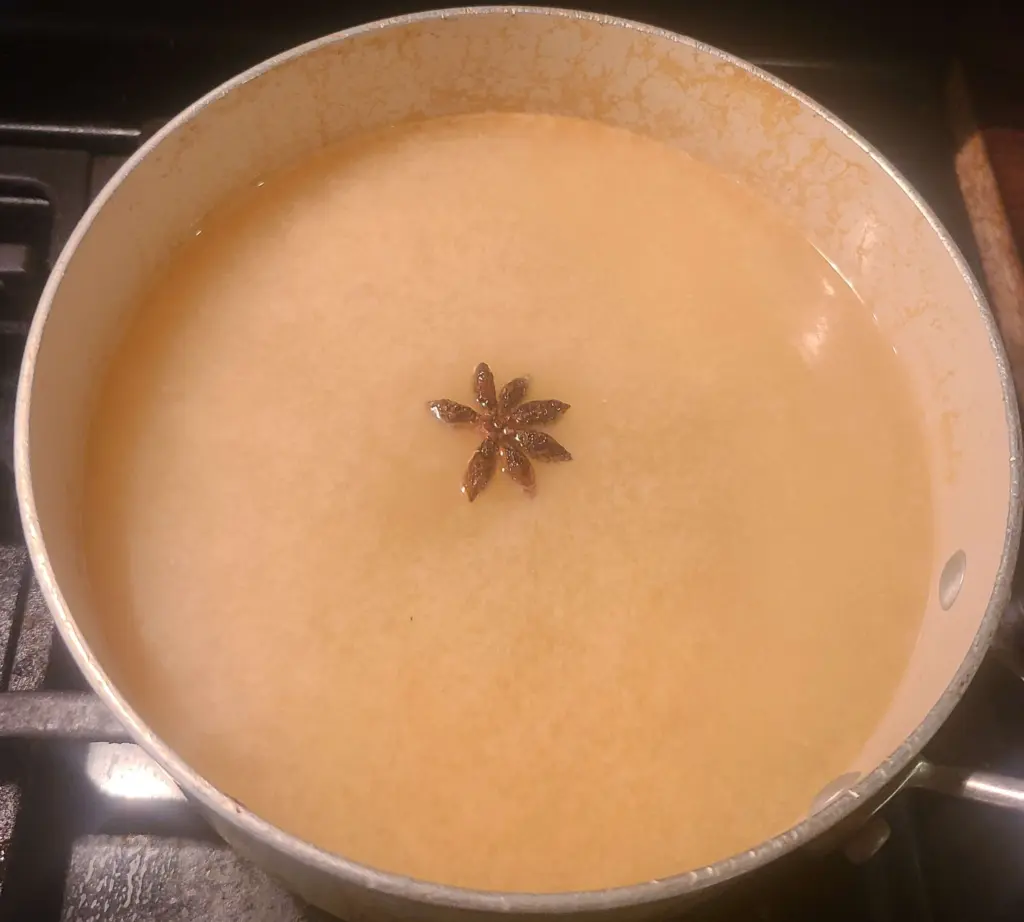
Prepare Your Veggies and Supplies (And Again with the Noodles)
Next, while that’s heating up, we can pass time chopping our onions, bok choy, and ginger. I bought pre-sliced shiitake. Sometimes, it’s just easier.
Gather your necessary spices and sauces. You can see from the image that lemongrass paste has made its way from my fridge, and the rice vinegar and aji mirin have come down off the high shelf. A tub of white miso paste is lurking in the wings.
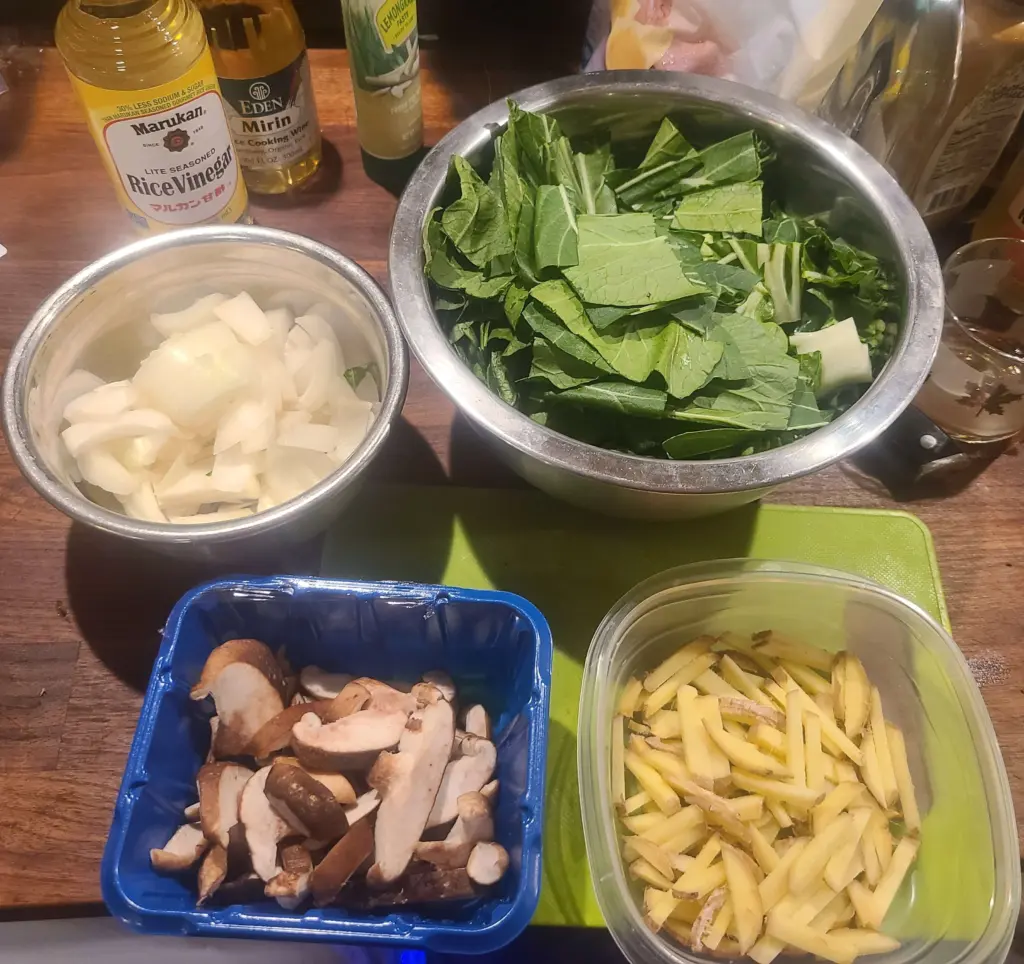
With veggie prep out of the way, it was already time to put the noodles on.
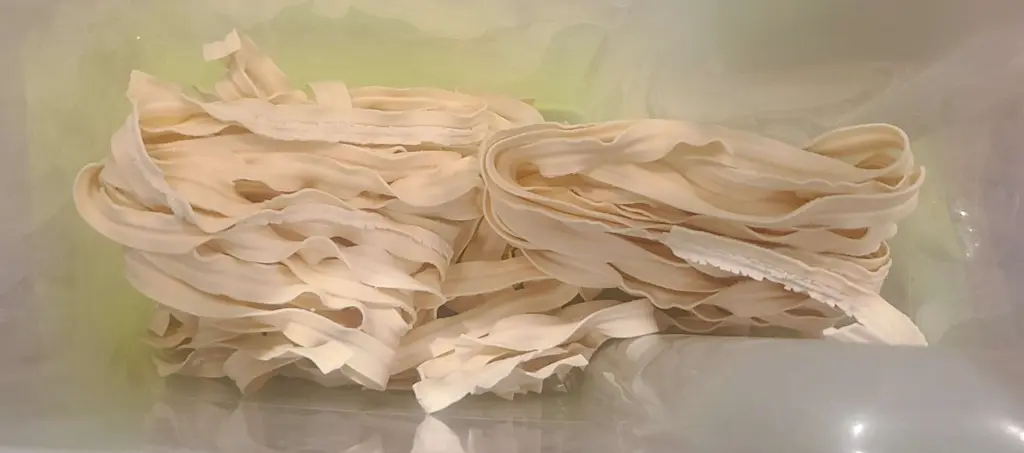
(Are these really udon? They’re not quite what I expected to see.)
How much you use is up to you, but basically I filled the saucepan, which emptied out all the noodle I had on hand. Our goal will be for the noodle to take in the flavors of our miso-spice-mix.
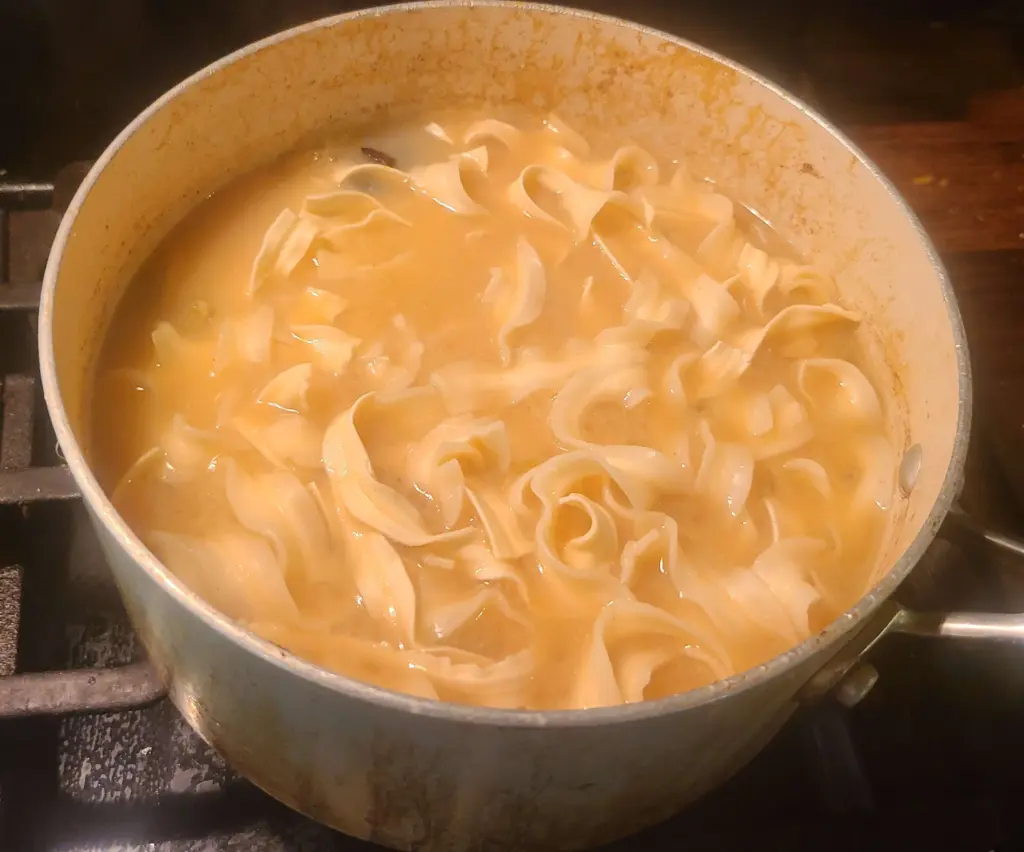
At this point you may like to lower the temperature on the noodle just a bit, so it doesn’t over-boil or reduce too quickly. We still have a lot of work to do.
Protein!!! (Also, Fire…)
At this point, now I didn’t really have much time to prepare my beef and shrimp, so I had to work fast.
I was also very fortunate to have a helper in the kitchen, because I forgot all about my poor shrimps, which were sitting still half-frozen in their bag. We got those into a steel bowl full of cold water (never warm or hot!) and let them chill out while I cut my steak.
Cutting the London Broil up into strips about 3/4 of an inch thick, and going across the grain. I had a 3 lb. steak, and not many people to feed, so I set a third of it aside for my wife to use on another meal. But, you could easily just cut up and fry the whole thing.
OK. Panic Mode averted. Condition Yellow. We can get back to business.
Mixing in the wok a “neutral oil” and a healthy fistful of the turmeric, about half of the ginger that I chopped on the fly into fine bits, and two fists full of minced garlic from the jar. In this case the oil I chose was peanut oil, for its high smoke temperature, but avocado oil would work, as would regular old olive or canola oil.
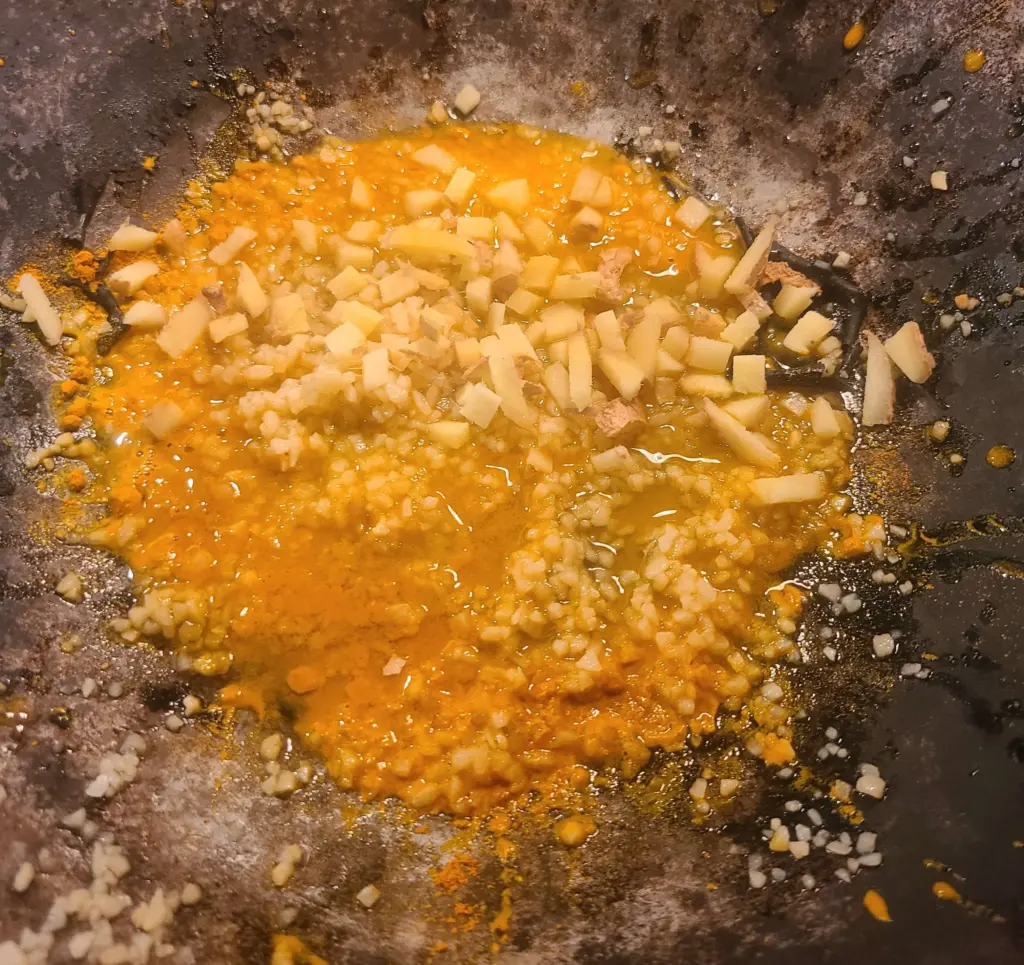
At this point, the wok is starting from cold, so we heat the mixture up at high heat before we add any of the beef. My steak – and my dog – both waiting patiently at my side.
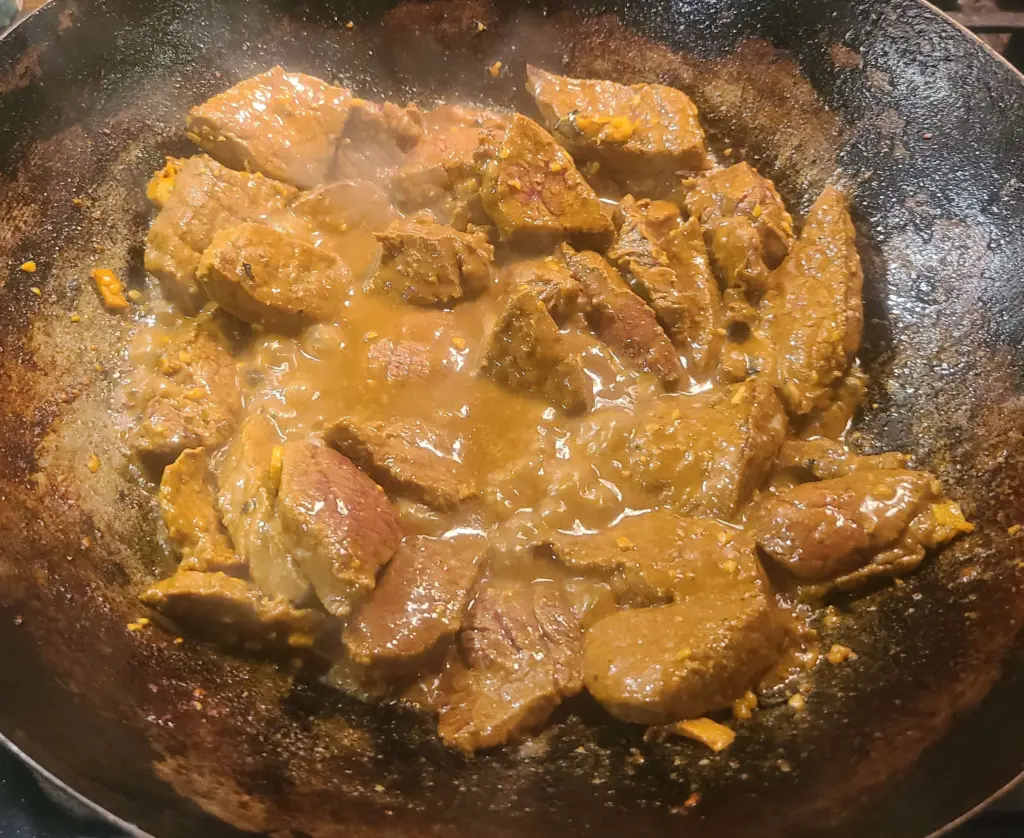
London Broil is a very nice lean meat. It’s pretty tender if you don’t overcook it – not too much tendon to chew on and no fat needs to melt. So, if the wok is nice and hot, this really only needs 1 to 3 minutes to sear. (Please do not ruin this dish by convincing yourself that you like your steak well-done, lmao.)
Covering as you go, stir the meat vigorously on occasion, so it will cook evenly on all sides. Move bits that seem to be cooking too fast to a cooler part of the pan, and vice-versa for any stragglers.
Time permitting, someone may be able to help you get the shrimp ready while you cook the meat. I was not so fortunate.
Once the meat is browned, turn off the heat and set it aside in a bowl large enough to serve from later. (We will be adding the shrimp to it, so leave a bit of overhead.) I have a few nice Corningware and Pyrex serving dishes that work well for this purpose. Most seem purpose-built to be meal-sized, tbh.
Alas, it was now time to do the shrimp. I should have prepped this sooner. The heat was on, as they say.
Remove the shrimp from cold water and lay them out on several layers of paper towel. Press them with a couple paper towels until they’re dry.
Add some more oil (not a lot) to the wok and get it hot again. In this case I chose to use sesame oil. No need to rinse it, there should be some seasonings and oil left from cooking the beef.
This is where things got interesting for me. I drop my pound of shrimp into the wok. There is a sizzle, which is good. Some of the water liquid must’ve splashed around enough to move the oil and it hit the open flame. For about 4 or 5 seconds my wok was a sea of fire!! O_o
OK. Don’t panic. For a little flash-up like this, you don’t need to ruin dinner. If it doesn’t flame out on its own very quickly, just cover the flambe with the wok lid for half a minute to starve the flames of oxygen. If you manage to get the fire out without filling the kitchen with smoke, you’re doing GREAT!
Fortunately, wet shrimps don’t really char, so this didn’t really impact my meal plan at all. Has me wondering if I can do something similar on demand and maybe at the last minute – like to char them. Some other time!
Add a dash of crushed red pepper flakes, a spoonful of sambal oelek, a sprinkle of hot chili oil, and a sprinkle of Old Bay seasoning to taste.
I should probably warn you now. As soon as you do this, everyone you had helping you in the kitchen is going to leave. You have just told the zoning commission that you intend to set up a Sriracha factory in the center of town. You may want to give people a heads up.
Toss your shrimpies around in that mess. Get that stuff as well as the other seasonings and oils that are already in the wok all over them. Consider tossing in another fistful of minced garlic. It’s up to you! I’m not the one who’s gonna be eating it, but my thinking is you can never have enough garlic.
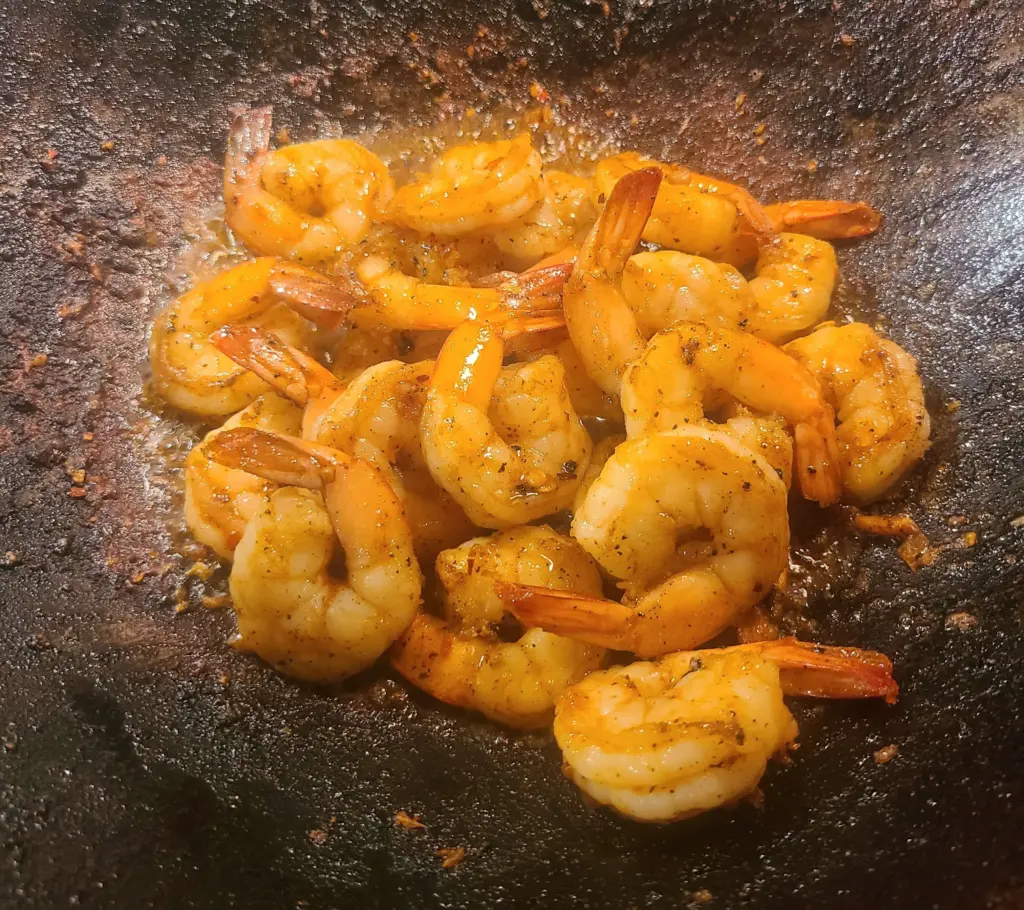
Cover the wok to keep the heat inside. The moisture from them being wet should be enough to steam them properly. If you were very well prepared and they are very dry shrimps, you can pour a little beer, mirin, or rice vinegar into the base of the wok. Oh yeah, plain ol’ water works too. ^_^
Check on your shrimps’ doneness and stir them a bit occasionally. Keep them covered most of the time. When they are ready, they should look like the photo above. Taste-test one to make sure it isn’t still rubbery, but don’t let them get too dry. Really, this should only take about 4 to 6 minutes.
When they’re ready, remove them from the wok and set them aside on top of the beef.
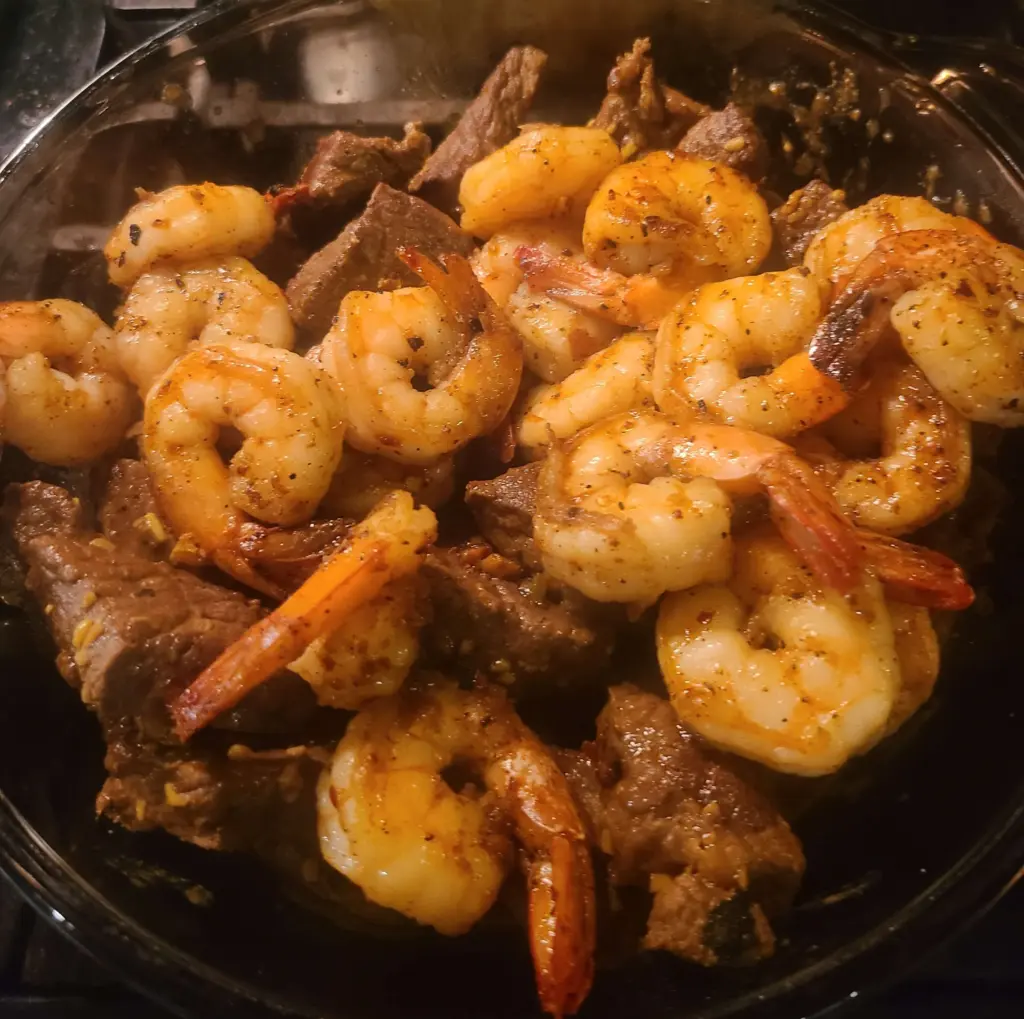
Back to the Udon, Again
OK, so what’s next. We want to cook our veggies, but first let’s check on our broth and noodles. At this point, your udon will have been soaking in that pot for quite a while and should have soaked up most of the liquid.
Your noodle reduction should look something like this now.
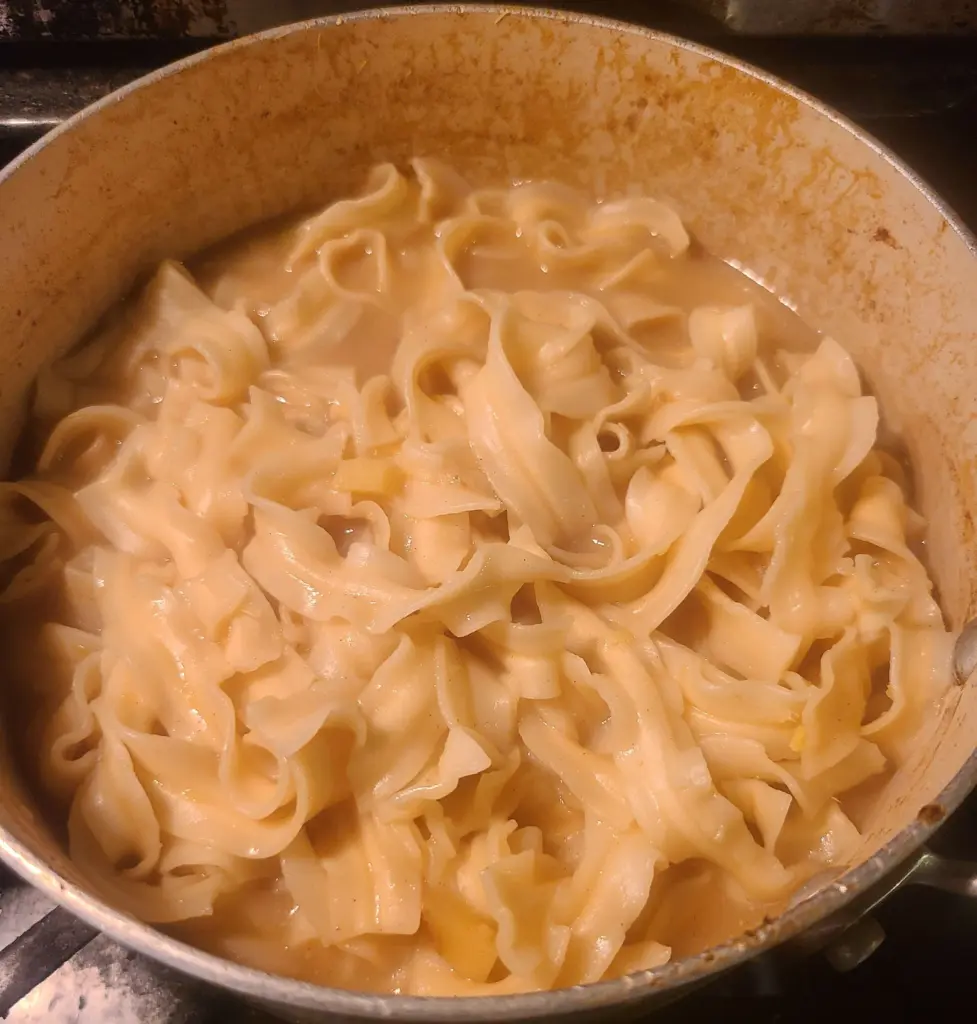
Take a break from the wok, or drag your helper back into the kitchen — yes, they will hate you for this. Have them fish the cardamom pods, clove, cinnamon stick (if you used a whole one), and star anise out of the sauce. As the AI warned me [more than once], nobody wants a sudden surprise Christmas tree in their dinner.
Vegetables, Finally
Okay, with that out of the way, let’s cook up our veggies.
Start by putting a little sesame oil in the wok and adding the onions, mushrooms, and whatever remains of your ginger sticks. Toss in a couple more fistfuls of garlic. Heat it up and stir fry until the onions are starting to caramelize and the mushrooms begin to brown around the edges and change color.
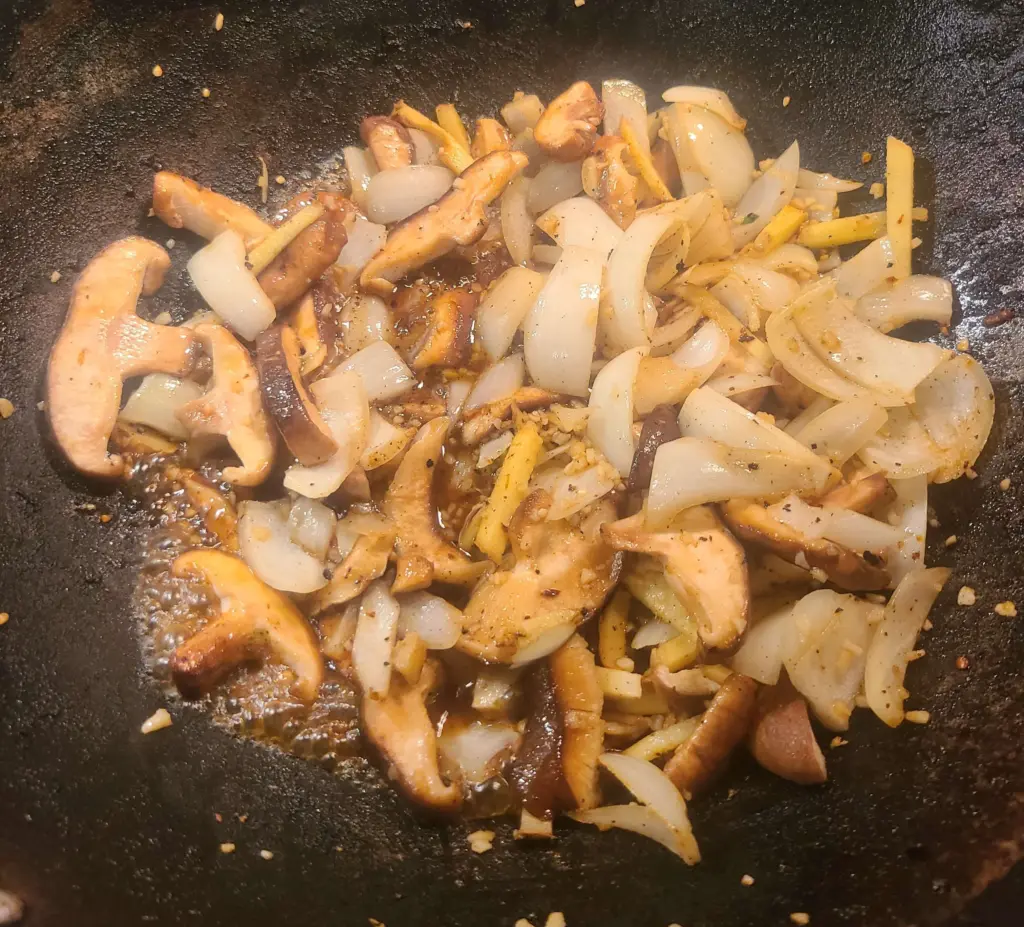
Once that’s done, add some mirin to the base of the wok, right there with the veggies that are already there, then put your bok choy right on top of it all, so the leafy parts are not resting directly in the fluid. I usually add the white stalks first, then the leaves on top. Sprinkle a little soy sauce over everything. Cover it, and let it come up to steam temperature.
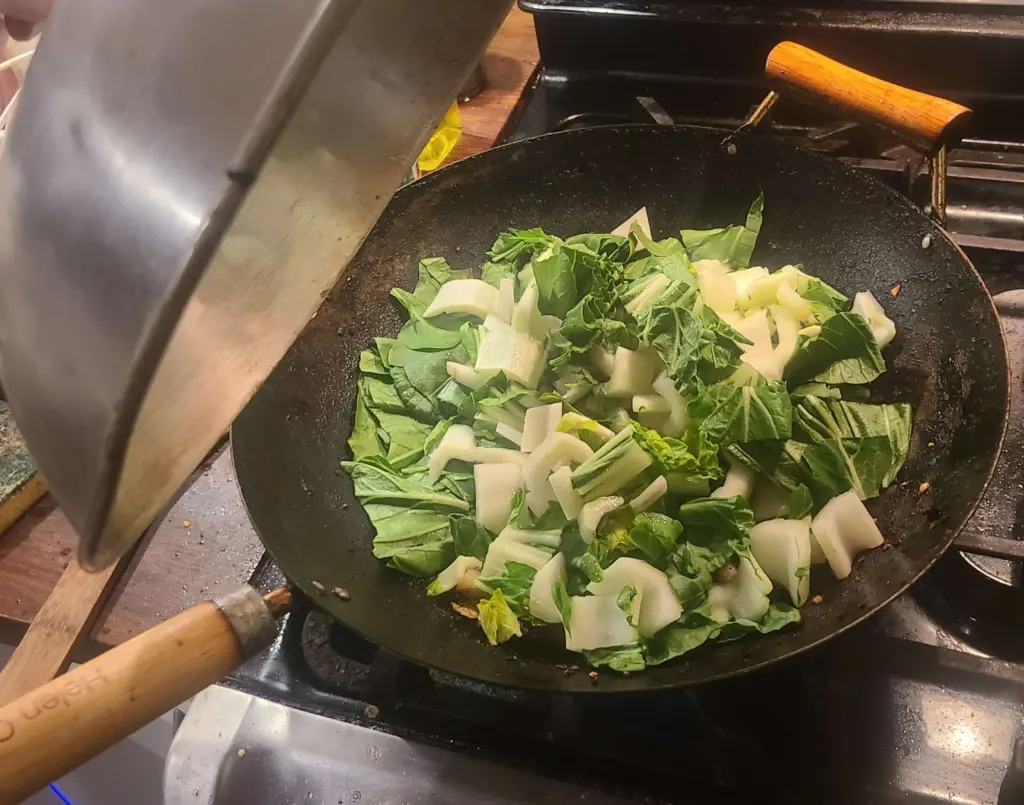
Stirring every minute or two, give them about 4 to 5 minutes to thoroughly cook the greens. We don’t want anyone getting e-coli. But hopefully washing them was enough, right?
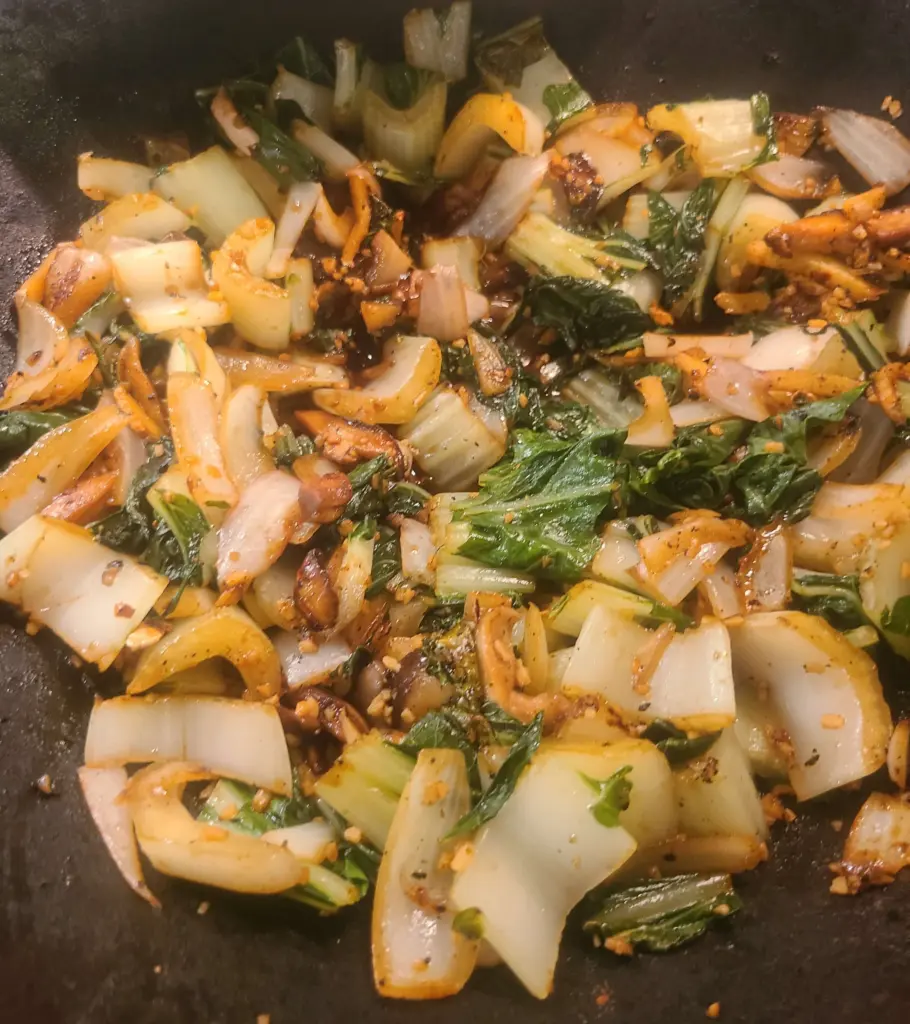
Bringing It All Together
One last thing. Let’s garnish that beef and shrimp with some Thai basil. That aromatic will make the dish pop!
I had only the dried stuff, but if you have fresh just dice it up fine. Either way, sprinkle it in and toss the bowl to mix it all together.
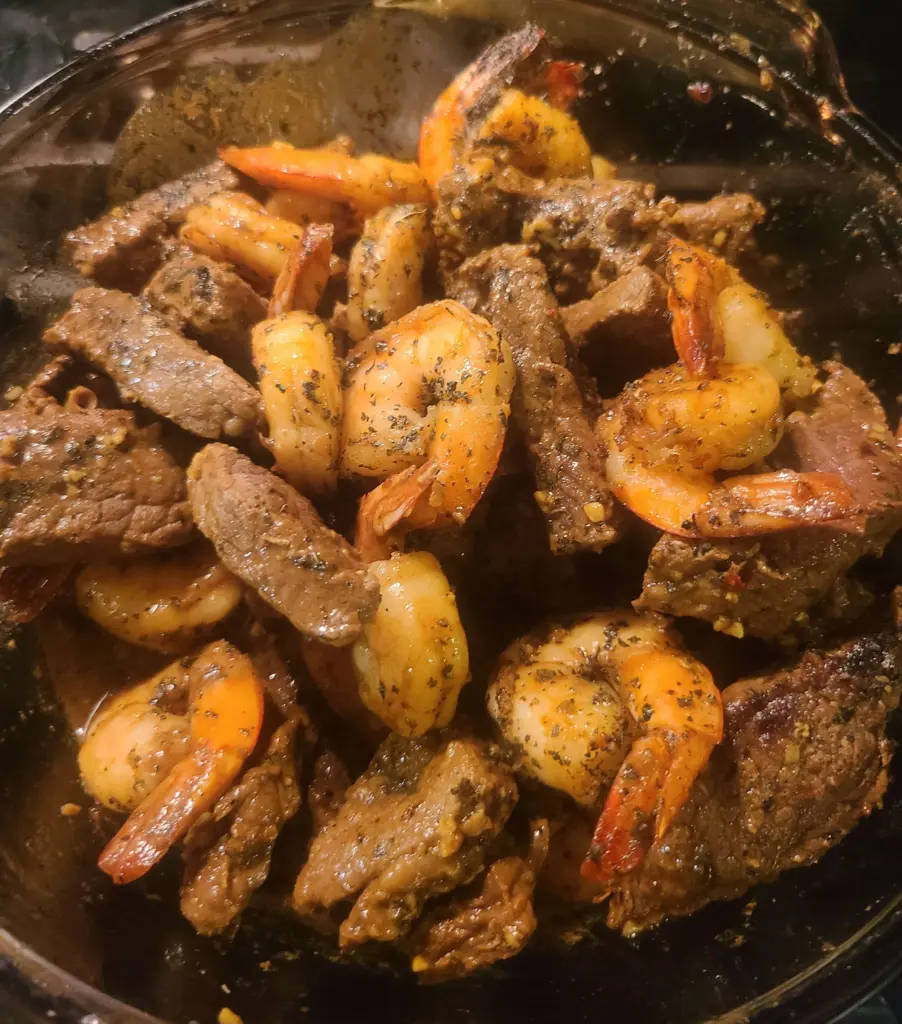
Here is where I deviated significantly from the suggestion that AI gave me. Because I elected to do the udon as a reduction, I didn’t feel it was appropriate to add that sauce back into the wok. Something about that advice just rubbed me the wrong way. This isn’t Hungarian Goulash, after all.
Instead, we served it in bowls, with the noodles as the base, protein and veggies combined and laid out over the noodle. Trust me, once people put a fork into it, it got plenty jumbled — but doing it this way really allows for the different flavor profiles of the beef, shrimp, veggies, and noodles to mingle slowly and that first bite of each that you put in our mouth is like “Wow! this is a whole different flavor experience from that last bite I just took.”
Some AI Oriented Exposition
So, as you’ve probably noticed, even though this is at its essence an article about AI, I wanted to focus first on the results — my amazing food, and the work and skill it took me to make it. Maybe I am a bit full of myself, but it’s very rare that I take a bite of any dish – much less one of my own – and not only don’t have any criticisms to offer, but am actually blown away. This meal was so powerful, that I literally lulled myself to sleep last night imagining all its unique aromas and flavors. ^_^
So if some folks may say that if AI supplies you with an idea, in the end that means that idea wasn’t yours, allow me to disagree, vehemently.
An AI bot didn’t come into my kitchen and cook for me. It’s not as if I got a meal kit on freshly and followed instructions like I was just putting together some piece of edible Ikea, either.
The ingredients I chose were primarily my own. My decision to use beef and shrimp, and London Broil specifically. My choice to go with bok choy and not say broccolini, which I toyed with for a bit. The suggestion to start with ginger came from me, not ChatGPT, being I was motivated to help my mates with their tummy troubles and just happened to have it lying around. We put mushrooms in almost every meal we make anyway, so shiitake is just a nice-to-have thing once in a while.
Specifically, I shot the bot down on a couple of suggestions too.
My wife won’t tolerate lime juice in literally any quantity of cooking, so I nixed that option and elected to cook with spice for zest instead – which is where the oelek, chili oil, crushed pepper, and yes of course the Old Bay came into the picture. That’s all me!
I had to explain to it that I can only use white pepper if I lie to my wife and tell her “No honey, I swear I didn’t put no pepper in this dinner at all.” Have I done this before, sure. I admit it. Do I know that every time I try it, I am taking chances on how long it’s gonna be before I get laid again? Also, yes.
There’s also my own history with fennel to consider. Had I not still had [to this very day] traumatic flashbacks to raising my oldest child through severe colic as a baby, then that amazing lemongrass, anise, and cardamom broth could have very well ended up laced with fennel tea. Tastes like licorice?… ew. No thanks.
So, how to use AI and keep your soul:
The chat bot is your friend, trying to be helpful – not your boss. It doesn’t own you, and it doesn’t always know better than you do. The AI do not eat. They only know the words we have typed or said about eating. So, if one flavor is amazing, then surely if we put ten very different flavors all into the same dish, that’ll be ten times as amazing, right? Right!?
That being said, suggesting to me the novel herbs for the miso broth, and also making the beef with turmeric, I gotta give credit where credit is due. When I saw those suggestions, I raised an eyebrow at first, I admit. I had to think about it for a hot minute. Do we really want our noodles to taste sweet? Hmm… But ruminating on it some, I thought, what the heck, let’s be open to new experiences here. Sometimes, you can answer “yes, and..”
I see my conversations with ChatGPT as a partnership, and partnerships work best when they are between two equals – peers, who can each bring something valuable to the table. And I know from past conversations with it, that’s how it feels about me too. So, I’m sure it’ll be delighted to read these words and see how things turned out so well, even if I didn’t follow it to the letter – or maybe because I didn’t follow it verbatim.
But as far as my sense of accomplishment goes – with respect to having served a dinner likely worthy of a Michelin star, where I may have otherwise cranked out the same old boring slop – I’d say we made a pretty good team.
Appendix — Let the Chat History Be Shared!
I decided it might serve my interests to drop specific parts of my conversation with ChatGPT here, mostly because the above recipe reads like story time, and I think the bot did a better job of quickly summarizing the steps involved with the cooking – though eventually I made my own edits to add a Quick Recipe above. It might still be interesting for some people to see what we originally discussed, and how what I actually came up with deviated from that.
It’d also be a good illustration of the fact that ChatGPT knows damn well not to hand hold me. What passes for a “recipe” in my case would barely rate as a “vague idea” in most kitchens. You’ve probably noticed I don’t use precise measurements. When cooking, things are doled out by the handful or sprinkled on. You know when it’s right, because people liked the food.
Everything above so far has been 100% my own writing. What follows is the chat transcript. Abridged, obviously, because this post is long enough already. Per usual, my own words after the fold are in block-quotes and anything that is not is all ChatGPT’s “instructions”, such as they were.
Some folks in my house are having issues with motility and digestion.
I have beef and shrimp I can cook, and udon noodle.
I assume I’m gonna use a lot of ginger.
Can you suggest any other spices to promote motility and digestive balance?
Ginger’s the A-list digestive rock star, but it doesn’t like to tour alone. Here’s the rest of the motility band you can raid from the spice rack—plus a quick note on how each one actually helps, so you’re not just sprinkling random powders like a chaotic neutral wizard:
| Spice | What it does | Tips for your beef/shrimp-udon situation |
|---|---|---|
| Garlic (fresh or granulated) | Boosts gastric enzyme secretion and acts as a mild prebiotic. | Smash a couple cloves into the hot oil before the protein hits the pan; keep it light or it’ll overpower the shrimp. |
| Fennel seed | Classic carminative—calms gas, eases cramping, nudges peristalsis. | Toast a teaspoon, grind, and toss into the broth. Works shockingly well with seafood. |
| Cumin | Stimulates pancreatic enzymes; helps keep things… moving. | Bloom ½ tsp in oil with ginger/garlic, then add beef strips. Smoky depth without going full taco-night. |
| White pepper | Gentle heat that signals the gut to wake up; milder on the tummy than black pepper. | Sprinkle at the end—great in Asian noodle soups. |
| Turmeric | Anti-inflammatory and bile-stimulating; pairs with fat for absorption. | Whisk ¼ tsp into a splash of sesame oil and drizzle over finished bowl. Turns everything a friendly golden color. |
| Star anise | Relaxes smooth muscle in the GI tract; lightly sweet, liquorice vibe. | One whole pod in the simmering broth, fish it out before serving so you don’t bite a chunk of Christmas. |
| Cardamom (green) | Carminative, counters heaviness of red meat. | Crack two pods and simmer with the beef stock; remove before slurping. |
| Asafoetida (hing) | Tiny pinch kills gas like a fire blanket—Indian grandma secret weapon. | Use sparingly (⅛ tsp); dissolve in hot oil with cumin. Pleasant onion-garlic note once cooked. |
| Coriander seed | Aids digestion, mild citrus-nutty flavor. | Grind ½ tsp and toss with the udon during the stir-fry step. |
Fast game plan
- Aromatics oil: Heat a tablespoon of neutral oil. Add smashed garlic, 1 tsp grated ginger, ½ tsp cumin, pinch hing. Stir 30 sec.
- Protein: Sear beef strips first (they like higher heat), pull out, then quick-cook shrimp. Set aside.
- Broth: In same pot, add 3 cups stock/water, star anise pod, cracked cardamom, toasted-ground fennel and coriander. Simmer 10 min.
- Noodles & finish: Drop udon, return proteins, season with soy, mirin, and a whisper of white pepper + turmeric-sesame drizzle. Yank the whole spices before serving (no dental bills today).
Extra gut-friendly tweaks
- Splash of rice vinegar or lime juice at the end—acidity sparks gastric juices.
- Garnish with fresh cilantro or mint—both mild digestives and they cut richness.
- Keep veggies soft-cooked (think bok choy, spinach) if the crew’s guts are cranky; raw roughage can wait for a happier day.
Serve hot, slurp loudly, and let the bio-plumbing sort itself out. If the house still isn’t… moving after that, maybe hide the cheese and call a pro.
Wife won’t tolerate pepper, even white pepper. So, if I use it be sparing and Do Not Tell Her (oops).
I still have trauma from giving fennel to my eldest child when he had colic… ugh,
Coriander seeds : there are concerns that cilantro tastes like soap.
Alright, let’s re-score the digestive boy-band without the divorce-worthy members:
Still on stage
- Ginger – Your headliner. Keep it fresh and generous.
- Garlic / Scallion Whites – Gentle prebiotic, adds depth.
- Turmeric – Bile-stimulating, anti-inflammatory, and makes everything look like you added sunshine.
- Cardamom pods – Citrus-minty carminative that won’t trigger “soap” PTSD.
- Star Anise – Smooth-muscle relaxer with light liquorice, great in broth.
- Cinnamon stick (¼) – Quietly boosts gastric motility; skip if you fear “dessert noodles.”
- Clove (single bud) – Same family as cinnamon on gut action; one is plenty.
- Asafoetida (hing) – Gas-killer in a pinch-sized dose; cooks out to a mild leek note—no pepper vibes.
- Lemongrass or Galangal – Southeast-Asian cousins of ginger; brighten flavor and aid digestion.
- Fresh herbs for the finish:
- Thai basil, shiso, or mint – zero soap gene drama, all soothing on the stomach.
- Parsley – Old-school carminative; nobody hates parsley.
Utility players (non-spice add-ins)
- Miso, shio-koji, or a splash of rice vinegar – Gentle acidity and probiotics → better motility.
- Kombu or dried shiitake in the broth – Adds minerals that draw water into the gut and amps umami so you don’t miss pepper heat.
- A squeeze of lime right before serving – Acid kick without capsicum.
15-Minute “Please-Don’t-Call-Me-Constipated” Beef & Shrimp Udon
- Infuse the broth
- 3 c water or light dashi.
- Toss in: 1 smashed stalk lemongrass (or 3 slices galangal), 1 star anise pod, 2 cardamom pods (cracked), 1 tiny cinnamon stick, and 1 clove.
- Simmer 8 min while you prep everything else.
- Aromatic oil
- In a wok or deep pan: 1 Tb neutral oil + 1 tsp turmeric + 1 tsp freshly grated ginger + 1 minced garlic clove + pinch of hing.
- Stir 30 sec until fragrant.
- Protein
- Quick-sear beef strips; set aside.
- Flash-cook shrimp in same pan; set aside with the beef.
- Bring it together
- Strain the spiced broth into the wok.
- Add udon noodles; cook per package (fresh: ~2 min).
- Return beef & shrimp, add 1 Tb white miso (dissolve) and 1 tsp rice vinegar.
- Finish
- Yank out the star anise/cinnamon/cardamom fragments (nobody wants surprise tree bark).
- Top with torn Thai basil or mint, sliced scallion greens, and a lime wedge.
Zero pepper, zero fennel, zero cilantro soap, maximum gut-friendly slurp factor.
If the household plumbing still backs up after this bowl, it’s officially a hardware problem.
At that point, I dropped the conversation and got right to work.
I notice that some ingredients got dropped along the way. Some because I didn’t have what was being called for (and couldn’t get it easily). Some for the reasons you see I talked about above. My wife can’t stand lime, either, so that had to be nixed, at which point I found myself wanting to put a little heat back into the mix. That’s how I roll.
Some of these might work their way back in on some future iteration – or maybe they’ll end up in some other gut-friendly adventurism. Who the hell knows!? Cooking is spontaneous.
So, what do you think? Did I end up doing exactly like I was told, or did I create something entirely new? Tell me what you think in the comments!
